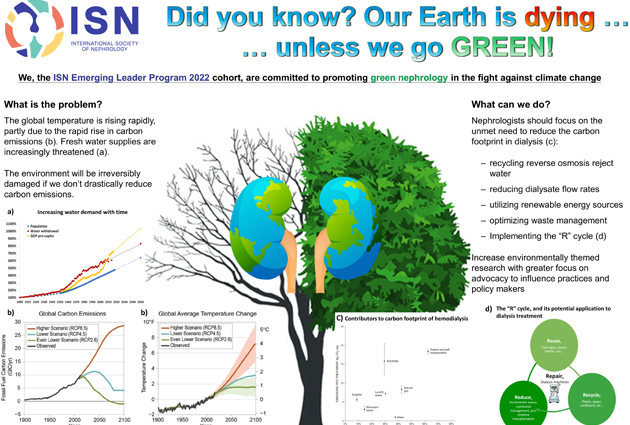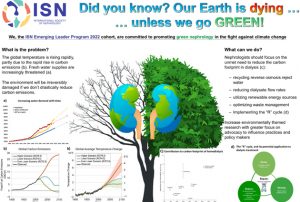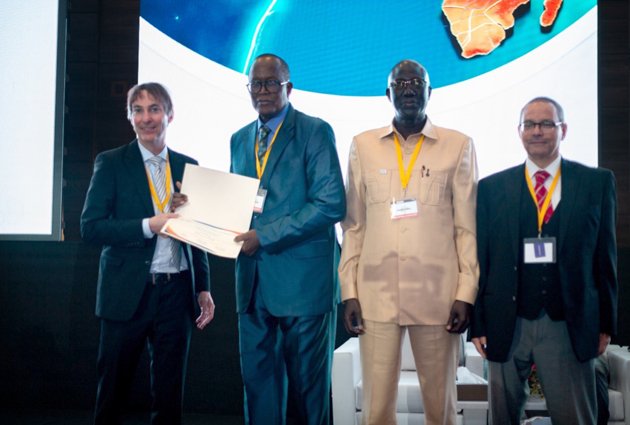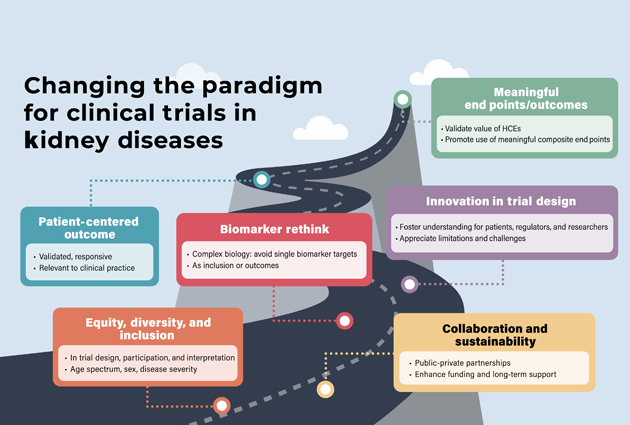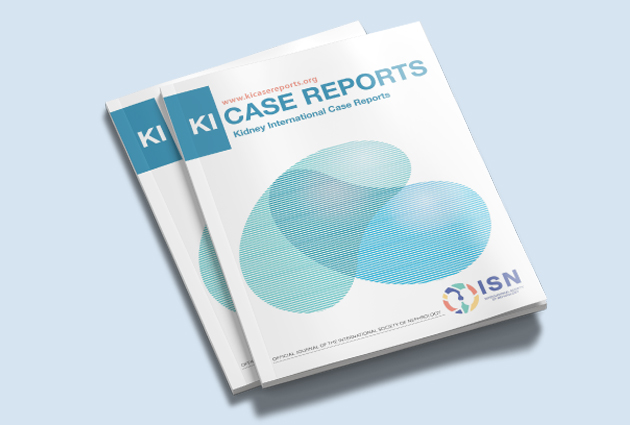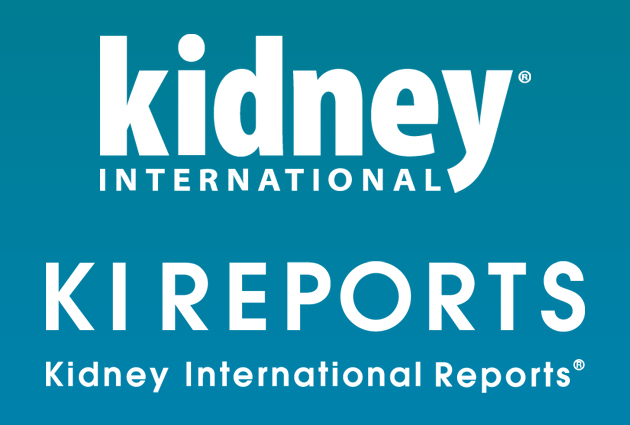The ISN ELP Program 2022 Cohort on Climate Change and the Urgent Need for Green Nephrology
By Wing-Shing Fung, on behalf of the ISN Emerging Leaders Program (ELP) 2022 cohort*
Climate change is the biggest health threat humanity is currently facing [1], and its impact on health is devastating. Indeed, climate change is expected to cause approximately 250,000 additional deaths per year between 2030 and 2050 [2]. The global temperature has been rising since the Industrial Revolution and is projected to increase by about 1.5°C by 2050 and 2-4°C by 2100 [3]. The Intergovernmental Panel on Climate Change has determined that to avert catastrophic health impacts and prevent millions of climate change-related deaths, the temperature rise must not exceed 1.5°C [4].
The best way to avert disaster is to reduce carbon emissions, the primary driver of global warming [5]. While every sector needs to play its part in reducing carbon footprints, the healthcare sector is particularly important as it contributes an estimated 4-6% of global greenhouse gas emissions [6]. Specifically, concerning kidney care, the carbon footprints of hemodialysis have been recognized to be particularly high, due to the high use of energy, water and consumables, and the repetitive nature of dialysis treatments [7]. There is less information on the ecological burden of peritoneal dialysis, but one analysis reported that the estimated environmental impact of peritoneal dialysis might be as much as hemodialysis [8].
“Green nephrology” is a concept that has been gaining traction over the past few years. It aims to improve the environmental sustainability of kidney care through changing practices and utilizing available resources in a more environmentally friendly way [9]. It also focuses on increased monitoring of resource usage and waste generation from kidney care facilities to reduce waste and the carbon footprint. Indeed, the environmental profile of hemodialysis can be improved in several ways, such as recycling reverse osmosis reject water; utilizing renewable energy; improving waste management and potentially reducing dialysate flow rates [10].
Contrary to common misconceptions, adopting “green nephrology” policies can actually improve cost-effectiveness and increase productivity [11]. The Green Nephrology Network, an NHS Sustainable Healthcare Programme in the United Kingdom, has saved an estimated 10 million Euros in their healthcare system annually as the result of environmentally friendly water and electricity saving initiatives [12,13]. Indeed, one of the dialysis units reported savings of up to 4 million liters of water per year with a new, more efficient water system [13].
Climate change is rapidly and potentially irreversibly changing our planet. It is imperative that we urgently reduce the carbon footprint in healthcare. As the International Society of Nephrology Emerging Leaders Program 2022 cohort, we are committed to promoting “green nephrology” in the fight against climate change. We believe that it is our responsibility, as emerging leaders of a new generation who will witness the full force of the changing climate, to take the initiative, speak up, advocate, and show leadership through a collaborative effort to promote the needed change. We also call for further research into novel technologies and policy innovation at a broader level, recognizing that a society-level change is required. The clock is ticking, and the fight is on.
* Winston Wing-Shing FUNG, Peace BAGASHA, Divya BAJPAI, Workagegnehu Hailu BILCHUT, Letizia DE CHIARA, Isabelle ETHIER, Ehab HAFIZ, Dearbhla KELLY, Ugochi ONU, Maria PIPPIAS, Shaifali SANDAL, Brendan SMYTH. All contributed equally.
The ELP 2022 cohort is mentored by Vivekanand JHA and supported by ISN staff Charu MALIK, Sophie DUPUIS and Anh TRAN.
Correspondence: Dr. Winston WS Fung, Department of Medicine & Therapeutics, Prince of Wales Hospital, The Chinese University of Hong Kong, Shatin, NT, Hong Kong, China.
Tel: (852) 3505-3146; Fax: (852) 2637-3852; E-mail: fws898@ha.org.hk
REFERENCES
- World Health Organisation: Climate change and human health, 2022. https://www.who.int/news-room/fact-sheets/detail/climate-change-and-health. Accessed on 26 July 2022
- World Health Organization. (2014). Quantitative risk assessment of the effects of climate change on selected causes of death, 2030s and 2050s. World Health Organization. https://apps.who.int/iris/handle/10665/134014. Accessed on 26 July 2022
- IPCC, 2014: Climate Change 2014: Synthesis Report. Contribution of Working Groups I, II and III to the Fifth Assessment Report of the Intergovernmental Panel on Climate Change [Core Writing Team, R.K. Pachauri and L.A. Meyer (eds.)]. IPCC, Geneva, Switzerland, 151 pp.
- Summary for policymakers. In: Global warming of 1.5°C. An IPCC special report on the impacts of global warming of 1.5°C above pre-industrial levels and related global greenhouse gas emission pathways, in the context of strengthening the global response to the threat of climate change, sustainable development, and efforts to eradicate poverty. Intergovernmental Panel on Climate Change; 2018. https://www.ipcc.ch/sr15/chapter/spm/. Accessed on 26 July 2022
- Solomon S, Plattner GK, Knutti R, Friedlingstein P. Irreversible climate change due to carbon dioxide emissions. Proc Natl Acad Sci USA. 2009 Feb 10;106(6):1704-9. doi: 10.1073/pnas.0812721106
- Malik A, Lenzen M, McAlister S, McGain F. The carbon footprint of Australian health care. Lancet Planet Health. 2018 Jan;2(1):e27-e35. doi: 10.1016/S2542-5196(17)30180-8
- Sehgal AR, Slutzman JE, Huml AM. Sources of variation in the carbon footprint of hemodialysis Treatment. J Am Soc Nephrol. 2022 Jun 2:ASN.2022010086. doi: 10.1681/ASN.2022010086
- Grafals M, Sanchez R. The environmental impact of dialysis vs transplantation. [abstract]. Am J Transplant. 2016; 16 (suppl 3). https://atcmeetingabstracts.com/abstract/the-environmental-impact-of-dialysis-vs-transplantation/. Accessed July 27, 2022.
- Agar JW. It is time for “green dialysis”. Hemodial Int. 2013 Oct;17(4):474-8. doi: 10.1111/hdi.12063
- Barraclough KA, Agar JWM. Green nephrology. Nat Rev Nephrol. 2020 May;16(5):257-268. doi: 10.1038/s41581-019-0245-1
- Piccoli GB, Cupisti A, Aucella F, Regolisti G, Lomonte C, Ferraresi M, et al; On the behalf of conservative treatment, physical activity and peritoneal dialysis project groups of the Italian Society of Nephrology. Green nephrology and eco-dialysis: a position statement by the Italian Society of Nephrology. J Nephrol. 2020 Aug;33(4):681-698. doi: 10.1007/s40620-020-00734-z
- Connor A, Mortimer F. The green nephrology survey of sustainability in renal units in England, Scotland and Wales. J Ren Care. 2010 Sep;36(3):153-60. doi: 10.1111/j.1755-6686.2010.00183.x.
- Limb M. NHS could save £1bn by adopting green strategies used in kidney units. BMJ. 2013 Jan 28;346:f588. doi: 10.1136/bmj.f588

